Contact
NESS Wärmetechnik GmbH
Remsstrasse 24
73630 Remshalden - Germany
Tel. +49 (7181) 9675 0
Fax +49 (7181) 42612
News
 PLC module for volume calculation11. November 2025 - 15:59
PLC module for volume calculation11. November 2025 - 15:59 Stadtwerk Tauberfranken GmbH – District heating from biomass20. August 2025 - 11:03
Stadtwerk Tauberfranken GmbH – District heating from biomass20. August 2025 - 11:03 NESS Wärmetechnik wins CATL’s “Excellent Supplier Award”4. August 2025 - 9:52
NESS Wärmetechnik wins CATL’s “Excellent Supplier Award”4. August 2025 - 9:52 Summer Party 2025: A colorful journey back to the 90s17. July 2025 - 15:58
Summer Party 2025: A colorful journey back to the 90s17. July 2025 - 15:58









